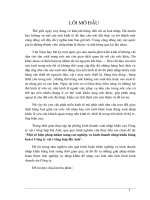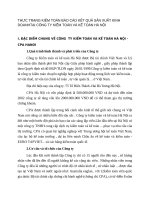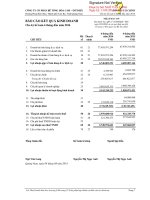Báo cáo hỗ trợ cải cách môi trường kinh doanh.pdf
Bạn đang xem bản rút gọn của tài liệu. Xem và tải ngay bản đầy đủ của tài liệu tại đây (805.2 KB, 48 trang )
PRACTICAL GUIDANCE FOR DEVELOPMENT AGENCIES
SUPPORTING BUSINESS
ENVIRONMENT REFORMS
PRACTICAL GUIDANCE FOR DEVELOPMENT AGENCIES
2008 Edition
Donor Committee for Enterprise Development
DCED
Supporng Business Environment Reforms:
Praccal Guidance for Development Agencies
Donor Commiee for Enterprise Development
www.Enterprise-Development.org
www.Business-Environment.org
August 2008
i i
This Guidance represents consolidated views of the members of the Donor
Commiee for Enterprise Development (DCED). Although every possible
eort has been made to reach consensus on the text of the Guidance, it
does not necessarily reect the views of each and every agency-member of
the DCED. Likewise, it does not necessarily reect the formal view of the
management and respecve governing bodies of the development agencies-
members of DCED or the governments they represent. The informaon
provided in this guidance is not intended to serve as legal advice.
Copying and/or transming porons or all of this work requires permission
from DCED. DCED encourages disseminaon of its work and will grant
permission promptly. All requests should be directed to the DCED Secretariat
by email:
Acknowledgements
This Donor Guidance has been produced by the Business Environment
Working Group (BEWG) of the Donor Commiee for Enterprise Development.
Simon White, consultant to the BEWG, is the principal author. The following
BEWG members were closely involved in the producon of the guidance:
Andrei Mikhnev (Internaonal Finance Corporaon), Marn Clemensson and
Graeme Buckley (Internaonal Labour Organisaon), Caroline Ramaekers
(Netherlands Ministry of Foreign Aairs), Corinna Küsel and Susanne Hartmann
(German Development Cooperaon), Dag Larsson and Chrisan Fougner
(Norwegian Agency for Development Cooperaon), Lasse Møller and Theo
Ib Larsen (Danish Ministry of Foreign Aairs), Richard Sandall, Tony Polatajko,
Mavis Owusu-Gyam, Roger Nellist and Nick Godfrey (UK Department for
Internaonal Development), M’Hamed Chérif (European Union), Juergen
Reinhardt and Zeynep Taluy (United Naons Industrial Development
Organizaon), Sco Kleinberg and Wade Channel (USAID), Jonathan Brooks
(United Naons Development Programme) Love Theodossiadis (SIDA), and
Jim Tanburn (Donor Commiee Secretariat). The BEWG acknowledges the
many individual and agency contribuons to the revision of various dras
of the guidance, including the parcipants of the Bangkok (2006) and Accra
(2007) regional conferences. In addion, many people contributed through
the Donor Commiee blog and various meengs over the last two years.
i i i
List of Acronyms and Abbreviations
ASEAN: Associaon of South East Asian Naons
ASMED: Agency for Small and Medium Enterprises Development
BEWG: Business Environment Working Group
CP: Co-operang Partner
DCED: Donor Commiee for Enterprise Development
HRD: Human Resources Development
IFC: Internaonal Finance Corporaon
LGU: Local Government Unit
OECD: Organisaon for Economic Co-operaon and Development
PSD: Private Sector Development
SADC: Southern African Development Community
SIDA: Swedish Internaonal Development Co-operaon Agency
SMEDSEP: Small and Medium Enterprises Development for Sustainable
Employment Programme
UNIDO: United Naons Industrial Development Organisaon
USAID: United States Agency for Internaonal Development
Key Messages
i. A healthy business environment is essenal for growth and poverty
reducon. Business environment reform is needed where inappropriate
regulaon, excessive taxaon, lack of fair compeon, lack of voice and an
unstable policy environment restrict investment and the development of
markets, se entrepreneurship and force many businesses to operate in
the informal economy.
ii. Business environment reform is complex, operang on many levels and
involving a very wide range of stakeholders. Development agencies should
therefore ensure a thorough diagnosc analysis and maintain, as far as
possible, a systemic approach and an understanding of the broader causal
picture.
iii. Business environment reform is always polical and development agencies
should therefore take care to analyse the polical context. They should have
strategies to build coalions of support and to engage with those who wish
to protect the status quo.
iv. Government should lead and own reform; donors should support them.
The right balance between internaonal and local experse must also be
found.
v. Development agencies should ensure that the inputs and parcipaon
of all stakeholders, including policians, ocials, the formal and informal
private sector, and civil society, are reected in the reform process. Reform
intervenons should be designed to enhance stakeholder capacity for
ongoing and future reforms.
vi. Development agencies should ensure that systems are in place for donor
coordinaon and take responsibility for the quality and consistency of the
advice and assistance they provide.
vii. Development agencies should sequence reforms according to context.
“Quick wins” and taking advantage of ad hoc opportunies such as changes
of government, may build reform momentum. However, a long-term
perspecve is essenal to ensure sustainability.
viii. Development agencies should understand and manage the implementaon
gap typically found between the adopon of regulaon or principles, and
changing pracce and enforcing regulaons on the ground.
ix. Development agencies should ensure the reform process has a strong
communicaon programme so that all stakeholders are engaged and made
aware of the benets of reform.
i v
Table of Contents
Key Messages .............................................................................................. iv
I Introducon ............................................................................................... 1
Purpose of this guidance and intended readership ......................................1
Dening the business environment and the focus of the guidance ............. 2
Objecves of business environment reform ................................................ 3
II Dimensions of business environment reform .......................................... 8
Levels of business environment reform ....................................................... 8
Supporng regional business environment reforms ........................... 10
Supporng naonal business environment reform.............................10
Supporng sub-naonal business environment reform ......................12
Supporng sector-specic business environment reform ................... 14
Funconal areas and their various levels ................................................... 14
Programme-cycle phases in supporng business environment reform ..... 17
Phase 1: Diagnoscs: assessing the business environment ................ 18
Phase 2: Designing reform support programmes ................................ 19
Phase 3: Implemenng reform support programmes ......................... 20
Phase 4: Monitoring and evaluang reform support programmes ..... 21
III Principles of business environment reform support ............................22
Principle 1: Adopt a systemic approach to reform ..................................... 22
Principle 2: Understand and respond to the polical economy of reform ...... 22
Principle 3: Respond to and smulate the demand for reform and drivers
of change ........................................................................................... 23
Principle 4: Ensure domesc ownership and oversight of reform eorts ..... 25
Principle 5: Strengthen the role and capacity of key stakeholders .............26
Principle 6: Focus on what the private sector needs through
public-private dialogue ...................................................................... 27
Principle 7: Focus on the binding constraints to business growth and
scope reforms accordingly ................................................................. 28
v
Principle 8: Sequence business environment reforms and allow me .......29
Principle 9: Address the implementaon gap ............................................ 29
Principle 10: Formulate a communicaon strategy and use
media strategically............................................................................. 30
Principle 11: Work with government as the lead agent ............................. 31
Principle 12: Align business environment reforms with naonal
development plans ............................................................................ 32
Principle 13: Ensure good donor coordinaon ........................................... 33
Principle 14: Balance internaonal and naonal experse ........................ 35
Principle 15: Promote quality assurance in development agency support
of business environment reform ....................................................... 35
IV Conclusion ............................................................................................. 36
v i
List of Figures
Figure 1: Dening the business environment ............................................... 2
Figure 2: Some examples of how business environment reform contributes
to achieving the Millennium Development Goals ........................................ 5
Figure 3: Levels of business environment reform .........................................8
Figure 4: Phases of business environment reform support programmes ..........18
List of Contested Issues
Contested Issue 1: Can we measure the extent to which business
environment reform contributes to economic growth and poverty
reducon? .................................................................................................... 3
Contested Issue 2: Should business environment reform focus on enterprises
that are owned and managed by poor people? .............................................. 7
Contested Issue 3: Should development agencies simply respond to
demand for reform or should they also contribute to creang a demand
for reform? .................................................................................................. 25
Contested Issue 4: Should development agencies support individuals or
instuons? ................................................................................................ 25
Contested Issue 5: Does support for the private sector interfere with
polical processes? .................................................................................... 28
Contested Issue 6: What role should government play in enterprise
development? ............................................................................................ 32
List of Text Boxes
Box 1: The process of business environment reform in Vietnam 2005 ...... 11
Box 2: Streamlining business permits and licensing procedures in
Ormoc City, Philippines .............................................................................. 13
Box 3: Beer Regulaon for Growth - improving the governance
framework for investment .......................................................................... 16
Box 4: Ukraine SME policy reform .............................................................. 30
Box 5: Donor coordinaon in Africa ........................................................... 34
v i i
v i i i
1
I Introduction
Development agencies support the programmes of partner governments.
While there are diverse views regarding the role development agencies can
play in reducing poverty through private sector development, much can be
gained by coming to agreement on key principles and pracces. The Donor
Commiee for Enterprise Development has been facilitang and documenng
these kinds of agreements since its formaon in 1979 and, having produced
guidance on nancial and business development services, now turns its
aenon to the business environment in which private rms operate.
1
Purpose of this guidance and intended readership
This document provides praccal guidance to development agencies to
improve their support for business environment reforms in developing and
transion countries, which aim at economic growth, job creaon, poverty
reducon and gender equality. It provides generally applicable, praccal
guidance for development sta in the design, implementaon and monitoring
of their programmes. While there are many contested issues, a selecon of
the most signicant being highlighted in the text, as well as a great deal of trial
and error in the eld of business environment reform, this guidance aempts
to provide good principles and pracces based on lessons learned. This
guidance has been prepared for the internaonal development community
at headquarter and eld levels, but it is hoped that programme partners will
also nd value in it.
Development agencies perform a unique and specialised funcon when
supporng reform processes in developing and transion countries – one
that diers from the funcons of governments, the private sector and other
civil society stakeholders. When performing these funcons, development
agencies respond to the demand in the country and to internaonal
commitments and draw upon a number of resources. These include high-
level policy frameworks that provide principles and guidance on how
development programmes should operate, such as the Paris Declaraon
on Aid Eecveness: Ownership, Harmonisaon, Alignment, Results and
Mutual Accountability. While there are resources available providing praccal,
1
For the guidance on nancial and business development services go to:
www.enterprise-development.org/resources/items.asp?cat=Guidelines
SUPPORTING BUSINESS ENVIRONMENT REFORMS
Business Environment
Policy and Legal Framework
Regulatory and Administrative Framework
Institutional Arrangements
Sector-Specific Business Environment
Regional, National and Sub-National
Business Environment
Investment Climate
Infrastructure
Open financial
markets, etc.
Rule of law
Political stability
Ec onomic
pred ic tability
Skills and
HRD
Equitable
and
efficient
labour
markets
2
step-by-step advice on how to undertake specic reforms, this document
provides guidance on how to apply broad, high-level policy frameworks
when designing and implemenng business environment reform support
programmes.
Defining the business environment and the focus of the guidance
For the purposes of this guidance the Donor Commiee for Enterprise
Development denes the business environment as a complex of policy, legal,
instuonal, and regulatory condions that govern business acvies. It
is a sub-set of the investment climate and includes the administraon and
enforcement mechanisms established to implement government policy,
as well as the instuonal arrangements that inuence the way key actors
operate (e.g., government agencies, regulatory authories, and business
membership organisaons including businesswomen associaons, civil
society organisaons, trade unions, etc.). See Figure 1.
Figure 1: Defining the business environment
Along with other private sector development iniaves, the business
environment aects the performance of private enterprises in both the
formal and informal economies. Business environment reform promotes
the development of markets that encourage compeon and enhance the
eecveness and sustainability of other development intervenons. A
INTRODUCTION
3
conducive business environment is one of the pre-requisites for economic
growth and poverty reducon (see Contested Issue 1). While poverty
reducon requires more than just economic growth, growth is an essenal
ingredient. However, in many developing and transion countries, the
business environment is hosle to market-led growth; private enterprises
suer excessive regulatory barriers and in most respects regulatory costs
are higher than in developed economies.
2
Poor business environments
are also more likely to have a disproporonal negave impact on women-
owned businesses, which are more likely to remain informal. However, it is
recognised that good regulaons are necessary to secure benets, protect
workers, consumers and the environment, to promote the rule of law and for
the ecient funconing of market economies.
Contested Issue 1: Can we measure the extent to which business environment
reform contributes to economic growth and poverty reducon?
While business environment reform contributes to economic growth and poverty
reducon, it is unclear how signicant this link is and whether it can be measured.
The World Bank claims that if a country reformed suciently to move from the
boom quarle to the top quarle of the Doing Business ranking, it would add 2.3
percent to the annual growth rate. However, others have contested the extent to
which such precision can be applied to this link, arguing that there is no simple,
linear relaonship between growth, income and regulaon. A low level of regulaon
is opmal for rich countries, and highly regulated middle-income countries can
benet from deregulaon. However, it is argued, regulatory reform may not be the
immediate priority in some poor countries, nor for middle-income countries with
low levels of regulaon. Moreover, consideraon should be given to the quality of
regulaon – not simply the volume – and the eect this has on rm behaviour.
SOURCES: (1) Djankov, S. et al. (2006) Regulaon and Growth, World Bank: www.doingbusiness.org/
documents/growthpaper_03_17.pdf
Objectives of business environment reform
Reforming the business environment is a priority for development agencies and
governments because of the signicant inuence the business environment has
on the development of the private sector and therefore on economic growth
and the generaon of livelihoods and jobs. Development agencies design
business environment reform support programmes in developing and transion
countries so that businesses are able to change their behaviours in ways that
2
Indigenous Private Sector Development and Regulaon in Africa and Central Europe: A 10 Country Study,
2002, by Bannock et al. www.businessenvironment.org/dyn/be/besearch.details?p_phase_id=35&p_
lang=en&p_phase_type_id=1
SUPPORTING BUSINESS ENVIRONMENT REFORMS
4
lead to increased levels of investment and innovaon, and the creaon of more
and beer jobs. This is done by:
reducing business costs: to increase prots (that may lead to increased a.
investment) or increasing market share (and thereby output and
employment);
reducing risks: poor or frequently changing government policies, laws b.
and regulaons pose a risk for business, thus reducing the value of
capital and the number of aracve investments in the market; and
increasing compeve pressures through new entry: to smulate the c.
eciency and innovang incenves of the market.
Development agencies design programmes to support reforms in developing
and transion countries that improve the business environment by reducing
legal, instuonal and regulatory constraints for doing business and promong
a beer investment climate (Figure 1). They support governments and other
development partners (e.g., other state organs such as the legislature and the
judiciary, as well as the private sector and civil society organisaons) in their
eorts to make the business environment more conducive to the growth and
compeveness of the private sector. For development agencies, the principal
objecve of a beer business environment is the reducon of poverty and the
increase in producve employment opportunies, especially for the poor. Figure
2 provides some examples of how business environment reform can contribute
to the achievement of specic Millennium Development Goals.
INTRODUCTION
5
Figure 2: Some examples of how business environment reform
contributes to achieving the Millennium Development Goals
Millennium Development
Goals
Contribung Business Environment
Reform
MDG 1:
THE ERADICATION OF EXTREME
POVERTY AND HUNGER
Removing the constraints and barriers to
business establishment and growth so that
the private sector can contribute more to
economic growth and job creaon, as well
as removing the constraints and barriers to
parcipaon by the poor in market-based
economic acvies.
MDG 3:
THE PROMOTION OF GENDER
EQUALITY AND EMPOWERMENT
OF WOMEN
Reforming the business environment
addresses many of the problems
experienced by informal rms, the
majority of which are owned and managed
by women. Reforming the business
environment can also address gender-
specic regulaons and instuons which
constrain women who own and manage
their own businesses.
MDG 7:
ENVIRONMENTAL SUSTAINABILITY
Improving compliance rates among private
enterprises and ensuring that sound
environmental laws and regulaons are
enforced.
MDG 8:
A GLOBAL PARTNERSHIP FOR
DEVELOPMENT
Integrang naonal business environments
with global trade and investment
opportunies – promong an open, rule-
based, predictable, non-discriminatory
trading system, and a commitment to good
governance, development, and poverty
reducon.
Because business environment reform is a process and not a single event,
another objecve of development agency support is to make reforms
sustainable by building the capacity of key public and private stakeholders to
manage reforms over the long term. Emphasis should be given to supporng
the implementaon of reform and to improving the systems in which private
enterprises operate.
SUPPORTING BUSINESS ENVIRONMENT REFORMS
6
Poor business environments provide incenves for rms to operate informally or
extra-legally. Thus, improvements to the business environment can contribute
to reducing the size of the informal economy.
3
Development agencies should
support iniaves that examine the eect the business environment has on
the informal economy and the rights of those who work there (e.g., idenfying
barriers that prevent informal enterprises from graduang to the formal
economy and idenfying the incenves for formality and informality) and
how this varies between women and men. However, business environment
reform is not the only response required to the problem of informality. Because
informal rms oen experience substanal decits in terms of skills, access to
informaon and access to nance, they can be less able to enjoy the benets
of an improved business environment. Thus, private sector development
programmes that address the concerns of the informal economy should include
acvies that help these rms to be beer able to respond to emerging market-
driven opportunies.
While economic growth is an essenal prerequisite to poverty reducon, the
rate of poverty reducon is also determined by the paerns of growth and its
employment intensity. Specic, carefully targeted intervenons are necessary
to enhance the impact business environment reform has on poverty reducon.
This includes giving the poor greater opportunies to parcipate in markets and
reducing the risks and vulnerability poor people tend to experience at levels
greater than others in the business environment. It is widely acknowledged
that women are more severely aected by poverty than men and that gender
inequalies, especially in educaon and labour market parcipaon, result in
substanve losses in terms of economic growth. Therefore, in order to eecvely
reduce poverty and smulate pro-poor growth, intervenons and policies should
be designed in a gender-sensive manner and – if required – be complemented
by intervenons that specically target women in order to create an equitable
situaon for both genders. Addressing the challenges of poverty reducon
through business environment reform therefore entails two areas of focus:
ensuring the benets of economic growth created by business a.
environment reform are diused so that they benet the
poor (e.g., by increasing the demand for employment); and
3
See for example: hp://www.csd.bg/news/bert/nenova.pdf and hp://rru.worldbank.org/documents/
publicpolicyjournal/313Klapper.pdf
INTRODUCTION
7
ensuring the parcipaon of poor women and men in business b.
environment reform processes is increased.
4
Contested Issue 2: Should business environment reform focus on
enterprises that are owned and managed by poor people?
While the reducon of poverty is the ulmate purpose behind most development
agencies’ support for business environment reform, not all agencies agree on how
this is best achieved. Some agencies argue that general reforms of the business
environment are not sucient and there is a need to focus reforms on the specic
barriers that poor women and men experience directly when operang in the
business environment. Others argue that targeted approaches create addional
biases and market distorons, and are not consistent with a systemic approach
to business environment reform that improves the system for everyone. The
former approach aims to address equity issues directly, while the laer approach
highlights the concern that by directly addressing equity, new market distorons
will be created that dampen the benets of an improved business environment
on economic growth. A related aspect to this issue concerns the emergence of
a so-called ‘boom-of-the-pyramid’ approach to business environment reform
where the primary focus for reform is on the markets in which poor women and
men purchase goods and services. In this approach, the poor are seen as resilient,
creave entrepreneurs and value-demanding consumers. Development agencies
are advised to maintain a systemic approach to this issue. Whether or not they
support business environment reforms that focus on the poor, they should assess
the impact that these reforms have on markets and the broader economy. For
further informaon see:
OECD, Promong Pro-poor Growth: Policy Guidance for Donors:
hp://www.oecd.org/dataoecd/33/54/36570936.pdf
OECD, Promong Pro-poor Growth: Private Sector Development:
hp://www.oecd.org/dataoecd/43/63/36427804.pdf
OECD, Accelerang Pro-poor Growth through Support for Private Sector
Development: hp://www.oecd.org/dataoecd/53/21/34055384.pdf
4
Recent developments in the Making Markets Work for the Poor (M4P) are a good example of this emphasis
on pro-poor economic development. The M4P approach is a development objecve and a broad approach
to poverty eradicaon based on the premise that well-funconing markets can help reduce poverty by
delivering aordable products and services to poor people, oering poor people beer return on their assets
and labour, and presenng poor people with beer employment opportunies. Key documents on this
approach are available at: www.bdsknowledge.org
8
II Dimensions of business environment reform
This chapter describes three key dimensions to supporng business
environment reforms. First, development agencies should recognise the four
levels at which business environment reform can be supported (i.e., regional,
naonal, sub-naonal and sectoral). Second, reforms can also address key
funconal areas that aect business acvity described later in this chapter.
Third, there are four programme phases that can be used to guide development
agencies in their support for business environment reform.
Levels of business environment reform
There are various levels of the business environment that aect how reform
intervenons are designed, managed and assessed. Figure 3 displays a matrix
highlighng four levels of business environment reform.
5
The approach
taken to supporng business environment may vary according to the type
of government system that is in place (e.g., federal or unitary systems of
government).
Figure 3: Levels of business environment reform
Funconal Areas of Business Environment Reform
Levels of Business Environment Reform
Regional Naonal Sub-Naonal Sectoral
Key
Programme
Partners
Regional
development
bodies (e.g.,
AU, ASEAN),
regional
economic
communies
(e.g., SADC),
World Trade
Organisaon
Parliament, polical
pares, naonal
government ministries,
regulators, private
sector representaves,
business membership
organisaons, business
media, worker
organisaons, and
consumer groups
Sub-naonal
legislatures,
provincial,
regional and
local government
authories,
local business
associaons,
community-based
organisaons
Sector-
specic
business
associaons,
regulators,
government
authories,
policies
5
The categories presented in this matrix are not mutually exclusive. It is likely that development agencies will
work at dierent levels and, for example, that sectoral reforms can have a regional, naonal and sub-naonal
character.
DIMENSIONS OF BUSINESS ENVIRONMENT REFORM
9
Policy
and Legal
Framework
Improving
policies and
harmonising
laws and
regulaons
that improve
regional
trade and
investment
Improving naonal
policies and laws
that promote
compeon, open
markets and the
general condions
for private sector
development
Improving local
policies for
private sector
development
Sectoral
policies and
laws oen
deal with
promoonal
intervenons
and ways to
enhance the
value chain
Trade
policies,
laws and
regulaons
Compeon, tax,
trade, labour policies
and laws
Sub-naonal
policies for
regional
development,
local economic
development
and private
sector
development
Sector
development
policies
Regulatory
and
Administrative
Framework
Improving
the
regulaons
that hamper
regional
trade and
investment
Improving naonal
regulaons
that aect the
establishment,
operaon and closure
of private enterprises
Improving the
regulaons
created by
sub-naonal
authories
Improving
business
regulaons
that apply
to specic
industry
sectors or
sub-sectors
Trade
regulaons,
customs
administraon
Business regulaons;
tax laws and
administraon;
labour laws and
regulaon; trade
regulaons; customs
administraon
Business start-
up and licensing
procedures
Sector
licenses
and permits









